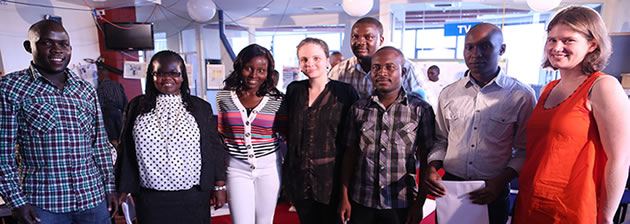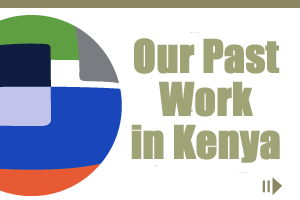By James Ratemo
Opening county health budgets, exploring the underlying causes of malnutrition in Turkana and corruption in Kenya's safety net program were just some of the projects that earned Internews in Kenya and its 2013 data journalism fellows recognition for its contribution to the open data movement by the Open Knowledge Foundation's Partnership for Open Data.
The joint submission by all five Internews in Kenya Data Journalism Fellows included stories published and broadcast by The Standard, The Nation, The Star and NTV and were all based on open data sources. The entry was named a runner up by Partnership for Open Data, a global partnership to help policy makers and citizens in developing countries understand and exploit the benefits of open data.
Congratulating the fellows, Internews in Kenya Country Director, Ida Jooste, said data journalism is the way to go as it promotes accountability in public service.
"The stories that have won recognition do what data journalism does best: they provide evidence, which helps journalists act on behalf of citizens as watchdogs. The best journalism keeps an eye on public servants. And when this is done through reliable evidence (not hearsay or gossip or criticism just for the sake of it), then journalism fulfills a vital function in society," said Jooste.
She said the open data culture ensures that the impact of the stories goes well beyond what's on the printed page.
"Public servants have accessed the same data and have chosen to use it to improve conditions. This is journalism as constructive criticism," added Jooste.
Michael Mosota attributed the success to great teamwork between the fellows and the Internews team.
"Thank you for the good work! It was a great team," said Mosota.
The competition was run by the Open Knowledge Foundation as part of the Partnership for Open Data, a joint initiative of the Open Knowledge Foundation, the Open Data Institute, and The World Bank
Participants were supposed to showcase how 'opening up data impact those in developing countries.'
About Internews Kenya Data Journalism Fellowship
The Data Journalism Fellowship prepares Kenyan journalists, developers and graphic designers to tell compelling data-driven stories through mass media that fosters a policy debate and public awareness of Kenya's healthcare challenges and solutions.
Due to the scarcity of open data, much of the challenge was identifying compelling public interest issues, accessing, scraping and cleaning relevant datasets, consulting experts during analysis and developing narrative and visual forms that raise public data literacy and engage them in an evaluation of Kenya's healthcare system. These projects would piece together disparate data sets and prove the need to invest further in open data.
Why focus on data-driven journalism?
Two major factors are working against the development of a thriving data community in Kenya and in many developing countries: weak or non-existent open data and a strong traditional media market.
Data is difficult to access and there is little financial incentive for the media industry to develop a formal data desk. In the West, financial necessity and a flood of new data catalyzed the formation of data communities.
Data journalism and open data are arguably even more essential in developing countries plagued by corruption and mismanagement and there is a plethora of talent from journalists and developers to artists and researchers committed to transparency but no formal environment for them to meet.Fruits from the fellowship
The Data Journalism Fellowship was an incubator for fellows to produce stories that led to public debate, policy change and investment in data projects, and most importantly, it spawned a small informal data journalism community that is committed to harnessing open data for journalism for its own sake.
Kenya has a thriving tech community but one that struggles to integrate into civil society and media projects or otherwise develop a civic hacking space.
Daniel Cheseret, the sole developer fellow on our team, learned the principles of data journalism along with the rest of the fellows. He produced the Change for Health Two open source Health News Apps namely: Unsafe Abortions Calculator, which shows the number of unsafe abortions procured in Kenya by second, minute, hour or day and Change for Health, which maps and graphs the funds county leaders are allocating for health, access to healthcare professionals based on government data. He said he also "learned the language of journalists."
"I am now working with journalists from various media houses to come up with visualizations on data, he explained. "One example is some statistics I was given to visualize on the hits on the websites of one of the major media houses in Kenya. I was able to come up with a bubble chart and a column chart using Tableau software, which I learnt to use during the fellowship."
Michael Mosota, a graphic designer from the Nation, now leads training in how to work with a diverse group to develop data visualizations at his newspaper and mentors them on various ways of handling print and online infographics from the conceptualization stage to final output based on open data.
"It was an interesting journey that we were required to develop a culture of teamwork," said Michael, the graphic design fellow from The Nation. "I have picked up that culture and now all the stories I work on I participate from the conception stage and I train other designers on print and online visualization tools."
All fellows struggled to convince traditional media outlets to modify their online publishing template to accommodate interactive content and story packages that include text, video, photos and interactive visualizations.
Many of the open data experiments in the country live on the web pages of an NGO, where it receives very little traffic but there is freedom to build to site to best showcase the findings of the investigation.
The journalists also had to rethink their workflow to ensure that they identified as many data sets as possible to support or refute their hypotheses and identify multimedia storytelling strategies to engage people in complex findings before persuading editors to accommodate innovative data-driven multimedia content.
Driven by too many questions on health financing in a devolved system of government, fellow Paul Wafula, a journalist from The Standard, used his data journalism training to get answers.
His story Change for Health was published as a five part series in The Standard. "I have come to appreciate what we have been missing in our reporting because the story I have done, if I had done it without data, my email would be full of questions," says Wafula, who examined whether the county budgets reflected local health crises.
"We expected that under devolution, the government would respond to the basic needs of the people and in West Pokot, they would now have the resources to deal with eye issues or if you are in Kilifi, you could address elephantiasis because that is your most pressing health issue that had been neglected by the national government."
He discovered that that the county governments' budgets were not easy to come by, even though they were supposed to be public and when I did find them and compared them to the previous year's budget, they were almost the same.
Wafula's second investigation focused on an emergency cash transfer safety net program for the poorest Kenyans including orphans and vulnerable children and revealed that legislators had changed the distribution formula for allocating Sh12.3 billion ($142 million) from an earlier model in which government poverty indicators dictated distribution to an equal division among counties in order to win the favor of wealthy constituencies.
"Being a poverty program, I knew that the poorer a place, the larger the allocation," explained Wafula. "Here you found that a constituents in which 30 per cent of the constancy was poor getting the same amount as a county where 80 per cent of the population was poor.
I realized that if you were poor in Lamu you were eight times more likely to get money than a poor person in Turkana. The data was provided by the government upon request but nobody had looked to see what the consequences of the reallocation would be on the poor.
After the story ran, Labor cabinet secretary Kazungu Kambi ordered an audit to identify and remove ghost recipients and other undeserving cases, developed new vetting committees that include community leaders to identify recipients and enlisted a private telecommunications company, Safaricom, to distribute the funding.Several agencies funding the project have raised questions about why the government allowed politicians to change the original distribution plan that had been approved by donors. Various stakeholders contacted the journalist and requested his raw data for further analysis.
"Data has shaped the way I look at facts, in the pursuit of truth in the stories I tell," he explained. My stories are richer, more evidence based and tighter. It has also become a great tool for me as an investigative journalist given that the numbers point me to where to look and find stories"
When the sun sets in Turkana; Hunger stakes and stripes in the North by fellow Mercy Juma ran as the lead news story on January 21.
The 12-minute, data driven story reveals that malnutrition in children is a growing problem in Kenya as famine become more intense and frequent. She was the first journalists in Kenya to cross publically available malnutrition data with drought data and foreign aid data to discover that underlying food security issues were being ignored. The station phone was ringing off the hook before the story finished airing.
Due to the massive reaction to the story from individuals and organizations, within hours the station established a relief fund for Turkana County as explained in the follow up story: Cases of malnutrition on the rise in Turkana hospitals
Mercy explained. "It should be the county government doing something but we learned that even the county government doesn't have a plan for nutrition for its people. The national government has plans and policies that are drafted but not discussed or passed and that is what motivated the story."
Besides raising public awareness and funds and sparking media attention to the crisis, the Drought Monitoring Committee asked Mercy to share data from her story because they claimed they were not aware that the situation had become so desperate although the same department had tried to charge her to access the data when she began her investigation.
Based on her water shortage data, the Ministry of Water plans to travel to Turkana to dig more boreholes.
The government through the Ministry of Planning and Devolution released Sh2.3 billion ($27 million) to go towards relief distribution in Turkana County, a development that Mercy is following closely.
Two stories, one by Mercy and another by Fellow Samuel Otieno, looked at the health and financial impact of unsafe abortions in Kenya, where abortion is illegal in all but the most extreme circumstances. Mercy's multimedia story links the high number of unsafe abortions in Kenya to low contraceptive use.
Her 10-minute TV story: Grave Choices, was aired on NTV. The print version was published as a cover story in The Daily Nation. A parallel story by fellow Samuel Otieno illustrated the financial drain on the country by fixing botched abortions rather than investing in contraceptive access through data provided by the Ministry of Health.




